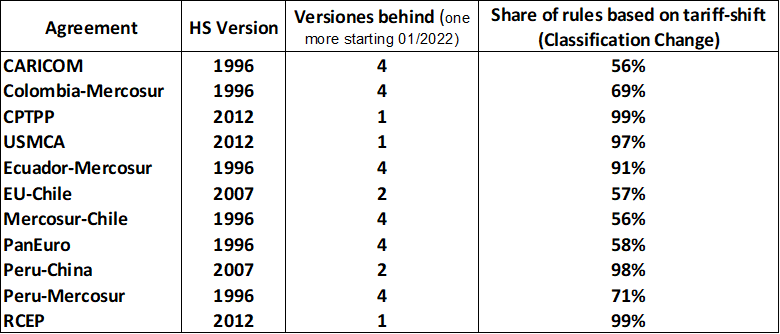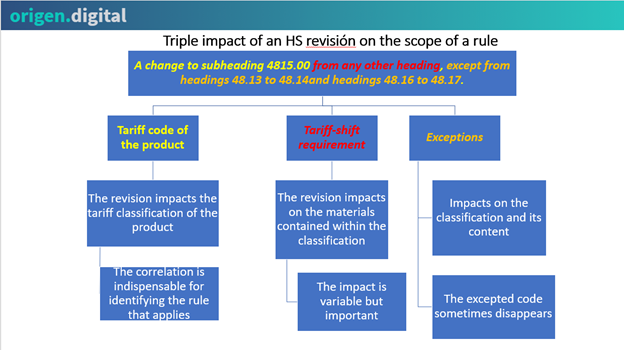A few weeks ago, a new and seventh version of the Harmonized System (HS) came into force. The HS is the tool used in international trade to classify products. Its updates are intended to include new technological innovations and new products derived from them, to improve the statistical monitoring of trade levels and to eliminate from the system those products that are no longer used and marketed. This multiplicity of causes implies that the changes among the different versions have different impacts on the various chapters and items that make up the HS.
The experience of all previous revisions shows us that the issue of rules of origin is an issue that is not a priority and is practically ignored when implementing and putting into effect the adjustments to the tariff nomenclature. This disregard distorts and complicates the the correct application of the origin requirements.
In this context, we have decided to begin our blog addressing this topic. In effect, with this post we start a series where we will comment on aspects related to the treatment, impacts and possible solutions that HS revisions have in terms of origin, and the problems associated with having the rules of origin in an outdated version of the HS. Later, we will address other issues raised in our introductory post. We start from the conviction that it should be a priority to keep the rules of origin updated in the current version of the HS for a correct application of their associated trade agreements. However, reality has repeatedly shown that, unfortunately, some competent authorities in matters of origin or the administrative commissions of the various agreements DO NOT share this view. This lack of interest and delay in updating the rules to the current version of the HS generates an imprecise and incorrect application of the origin requirements that promotes a lack of transparency, generates errors, and even contributes to corruption.
Now, is this disinterest in the impacts on rules of origin:
• Is because each update of the HS has no impact on the scope of a product’s origin requirements?
or
• Is because the adaptation of the rules of origin to the new version of the HS is a simple matter that any producer can carry out and it is not necessary for authorities to address them?
The answer to the two questions posed is NO. The revisions to the HS have a strong impact on products’ origin requirements and the technical adaptation of the rules is a complex activity that requires specialized knowledge that private producers and traders generally do not have.
Additionally, it is worth asking, is this neglect of the origin issue the reason why countries do not update the versions of the HS in which the origin requirements are expressed in trade agreements? Whether or not this is the case, from the point of view of origin the situation in which preferential trade currently operates is one in which there is a notable lag in the way the rules of origin are published and available for all products in most trade agreements. The following table shows some cases by way of example, as of early 2021:

Whatever updates may have been applied to the randomly chosen agreements in the table above, the reader can check the situation in the agreements of her or his own country and will find that frequently the version of the HS in which the rules are expressed is not identified, and where it is, note the degree of lag in their expression.
Faced with this situation, what partial and/or incorrect solutions are usually applied by public and private operators in the application and control of origin?
• They literally apply the text of the rule negotiated in an old version of the HS to the new position where the product is classified.
• They consider that it is only a customs problem that has an impact when classifying the product for tariff purposes, when in reality this is only the tip of the iceberg.
• They mask this situation by not informing the version of the HS in which the specific rules of origin annexes are expressed. By omitting this data, the non-expert user in the subject may incorrectly assume, in good faith, that the specific rules of origin are in the current HS version and that, consequently, they are adequately updated.
Whatever the reason for these practices, it is worth asking:
- Do they contribute to transparency in commercial operations?
- Do they degrade the application of the origin requirements in the trade agreement?
- Do they promote trade facilitation?
The delay or absence of revision to the rules of origin is frequently explained as a stemming from a lack of resources and capabilities for the task. In practice, when the responsible authorities do not carry out the updating of the rules of origin, the problem is transferred to the private actors in international trade transactions. In effect, traders will end up having to apply the correlation and adaptation of the origin requirements to the new HS version. In this sense, producers and exporters of a good, the certifying entities, customs agents in the exporting and importing countries, importers, etc. will have to carry out these tasks.
In this situation we ask:
- Will the interpretations and applications of all these agents coincide?
- Or on the contrary, will the result be a series of discrepancies and potential disputes?
- To facilitate trade, wouldn’t it be convenient to keep the origin annexes up to date?
How does an HS revision impact the rules of origin?
In order to measure the incidence of the outdated origin requirements, it is first necessary to identify in which instances of the preferential commercial operation it has an impact. There are fundamentally three stages where outdated rules lead to wrong answers, namely:
• When the product is classified in the nomenclature in order to identify the rules of origin that apply to it;
• When non-originating inputs restricted by the tariff-shift are identified, as these must be originating. In this regard, it should be remembered that the vast majority of specific rules annexes base more than half of the rules on tariff shift (change of classification) requirements, and in numerous agreements this participation rises to more than 90 percent of their rules; and
• When the restricted inputs are determined by exceptions to the change of classification requirement.
The following table graphically represents a simplified schematic of these impacts.

In this context, how can we operate correctly if we do not have up-to-date rules? Does the lack of interest contribute to facilitation of trade?
In our next post we will continue to answer this question, commenting and numerically demonstrating the number of tariff openings, affected by successive updates, explaining in greater detail the incidence of changes in the HS on the rules of origin, and explaining in more detail the distortions that changes in the HS generate in the rules of origin as negotiated. We will also be describing the automated solutions that Origen.Digital has developed in order to facilitate the adaptation of the original requirements to the version currently in force.
The floor is open! Let’s have a debate on the problems that HS updates generate for origin. Comments welcome!
2 replies on “Why are origin issues postponed when the Harmonized System is updated?”
The objective of a treaty is liberalization. In this sense, an article that will update from the correlatives would be interesting. And that only if the Trade Committees so decide, the specific rule will be reviewed.
Thank you very much, Juan, for your comments. I agree that governments should approve these updates.